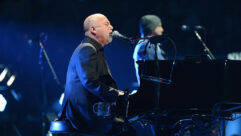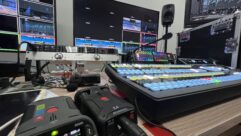Pipes of piecePutting together a sound system with a 2,300-piece pipe organ as the focal point takes special craftsmanship.
Nov 20, 1996 12:00 PM,
Chuck ShriverShriver is with Shriver Communications, Elk Grove Village, IL.
How is an orchestra similar to a subwoofer? “An opera singer performing with an orchestra is not in competition with the orchestra,” said David M. Ancker, project designer for Jacob Gerger and Sons of Croydon, Bucks County, PA. “If the composer has done his job well, he has provided a harmonic carpet, a carrier wave, so the singer is helped by the orchestra, not competing. That’s the point of subwoofers. They provide the carrier wave for the rest of the music.”
And that is why Ancker was so concerned with the quality of the subwoofer system he selected whenJacob Gerger and Sons was commissioned to build a new pipe organ for the West Lawn United Methodist Church in West Lawn, PA. “We were looking for a subwoofer system that would be very accurate,” Ancker said. “If it were inaccurate, the carrier principal would not only fail, it would compete and undo everything we were trying to do.”
Gerger brought a great deal of experience to the project: Jacob Gerger began building pipe organs in 1907 after arriving in the United States from Europe. Jacob and his son, Peter J. Gerger, formed a partnership in 1946. Peter J. Gerger Jr. is now president of the company.
A history of revisionWhat Jacob Gerger and Sons was doing for the West Lawn church was almost as involved as re-inventing the wheel. The building had been expanded three times since the installation of its 600-pipe Wicks organ in 1957. A critical evaluation of the winding, action and pipes of the organ indicated many problems.
The church’s nave comprised the original building, which housed the narthex and balcony and had a flat ceiling, and a newer A-frame continuation for nave seating and the chancel. (See Figure 1.) The organ was installed above the choir area to its left and right on the second floor. Curtain walls narrowed the chancel and provided exits from the nave.
Although swell shades faced the chancel and nave, the shades facing the chancel and choir singers would not open fully because of improper framing and congestion in the chamber. The singers could not hear the organ, nor could most of the congregation. This made for difficult, if not impossible, choir accompaniment. Choir singers were in facing stalls, and the altar was raised above the chancel floor. To make matters worse, the chancel area itself was completely carpeted and acoustically dead.
To achieve what the congregation wanted would require that the entire chancel area of the church be rebuilt (see Figure 2) and that digital voices be incorporated into the pipe organ with several provisos: each digital voice had to be independent, and only the best equipment could be used. Gerger provided the specifications for space, tonal revisions, winding, tuning, temperature control and interior changes required to improve both function and acoustics. The cost of the project was estimated at between $250,000 and $300,000.
“Some members of the congregation were a little concerned about changes in the chancel and what the pipe work would look like,” said Rev. Stacy D. Myers, senior pastor of West Lawn.
However, after the church’s development and music committees gave their final approvals, the 11-month project was under way in late 1993. A year later, West Lawn United Methodist’s beautiful new four-manual Gerger pipe organ and remodeled chancel were dedicated.
A long roadOver late 1993 and throughout 1994 came a great deal of hard work. New hardwood, tiered choir seating replaced the former design for better sound and visibility. The exposed great, positif and pedal pipe ranks were located above the choir singers against a stone wall. The pipe configuration, consisting of 2,300 pipes contained in two chambers and on the stone wall facing the nave, is diatonic and organized to provide an unobstructed sightline to the stained glass cross in the wall.
The swell chambers were enlarged four feet (1.2 m) toward the nave seating to provide for more wind chests and proper swell shade operation. Chambers on the choir level were constructed for the electronic pedal additions and the tubular chimes, and the four-manual, low-wide style instrument console, which was custom designed by Gerger to American Guild of Organists specifications, was placed in a pit. A glass-partitioned audio control room was constructed in the balcony.
“Voicing the pipe and electronic stops for clarity, projection and warmth of tone was completely successful,” Ancker said. “I am happy to say, without reservation, that not only does it work, it is the best sound I have ever experienced.”The end result was an organ with 35 ranks of 2,308 pipes and seven electronic voices. A MIDI expander provides 350 sounds.
Marrying tradition and electronicsFitting together the traditional pipe organ and the electronics is a careful process.
“In this installation are two channels, known by organ terminology as C side and sharp side,” Ancker explained. “The bass pipe of the organ forms a V with the longest pipe, the lowest tone, on the left and the next C-sharp on the right. The pedal board controls the pitches of this division, and the stops corresponding to the division select which ranks, or sets, of pipes will speak; hence, C side and sharp side,” he said. “The loudspeakers, two Bag End D18E-I double 18 enclosures and one Bag End D12-I double 12 on each side, are likewise placed to project the two channels.”
Amplification is provided by a separate Crown 1,600 W amplifier for each side, as well as a separate 200 W Crown amp for each double-12 loudspeaker. A stand-alone voice generator and digital interface designed and produced by Artisan Classic Organs of Toronto creates six different voices controlled from the console and played with the pedal or electronic division. The signal from the voice generator is wired to enter the Bag End ELF-1 integrator before being amplified.
“The seven voices include a 32-foot Contra Bourdon stop, which is the most difficult to reproduce because it is practically a sine tone at 16 cps, which is very punishing, if not impossible, to consistently project at a level equal to that of a real rank of organ pipes,” Ancker said. “A 32 foot (9.75 m) Contra Bassoon, which is not a sine wave, has an aggregate of upper partials evenly and faithfully reproduced by this system. A 32 foot (9.75 m) Contra Principal has a voice beginning at the 16 cps pitch, which, again, is an aggregate of upper partials but differing from the 32 foot Contra Bassoon. The remaining four voices are of the same families mentioned above but begin an octave higher at 32 cps.”
Ancker said he is not electronic high-tech anything. “I make my living by listening to opera singers, violinists, pianists and concert performers, telling them ‘this is what’s wrong with your vocal chords or your bow technique or whatever.’ I just apply the same criterion, aurally speaking, to what I hear through the faithfulness of the modern technological field as I would to a real situation. It’s got to sound real or I’m not interested.”
Getting a sound system to provide this type of realism is not always easy. “The 61-cycle low note of an open pipe organ is a 32-foot stop. That means that the pipe has a resonator 32 feet high. At a three-foot scale of low CCCC, resonance is approximately 288 ft3 (8 m3),” he said. “That’s what it takes to make the sound we are trying to get the loudspeakers to copy. “
An important factor in equipment selection is one that allows the electronic signal to be individually adjustable note-by-note.
“That’s important because you could take a very good set of loudspeakers, and, forget the curves and roll-offs, the room the loudspeakers are in varies terrifically,” Ancker said. “When you get below 64 cycles, those variations are inversely proportional. So when you are driving middle C with 25 W, if you go down to a 32 foot C, you are talking about 1,000 W. If the building is not favorable to those proportions, then you have to be able to adjust each tone of the scale to suit that acoustical situation and environment. Even then, buildings still produce hot notes. If you take a loudspeaker with a very nice linear factor to its profile and you give it the same power for the hot note as a note one or two notes away, you’ll have a huge difference unless you can adjust each note. Therefore I want the best loudspeakers I can find to handle those adjustments.”
Ancker said that as they tested loudspeakers, they ran into problems, finding nothing they deemed satisfactory after listening to a wide range of subwoofers.
“I didn’t like what I was hearing; they sounded dirty and were not true. When you talk about subwoofers, you’re talking about a fundamental tone that is hard to reproduce. You are asking a loudspeaker to reproduce a tone, one tone at a time, at frequencies below 32 cycles, at almost sub-hearing level – not an easy task.”Finally, Ancker called friend and former pupil Terry Dennis of Gary Castelluccio & Associates in Clifton, NJ. Dennis recommended Bag End loudspeakers. “I didn’t even test them before ordering,” Ancker said. “He guaranteed I would be happy with the Bag End subwoofers.”
The Bag End ELF subwoofer system has proved itself able to produce the organ voices with the necessary strength, according to Anker. “The 32-foot Contra Bourdon, for example, makes the room shake and at the same time remains clear and undistorted throughout the entire spectrum.”
The installation has met with rave reviews. “The new organ has added wonderful new dimension to our worship experience,” Rev. Myers said. “It was obviously installed with a great deal of care, and our people are thrilled with the result.”










